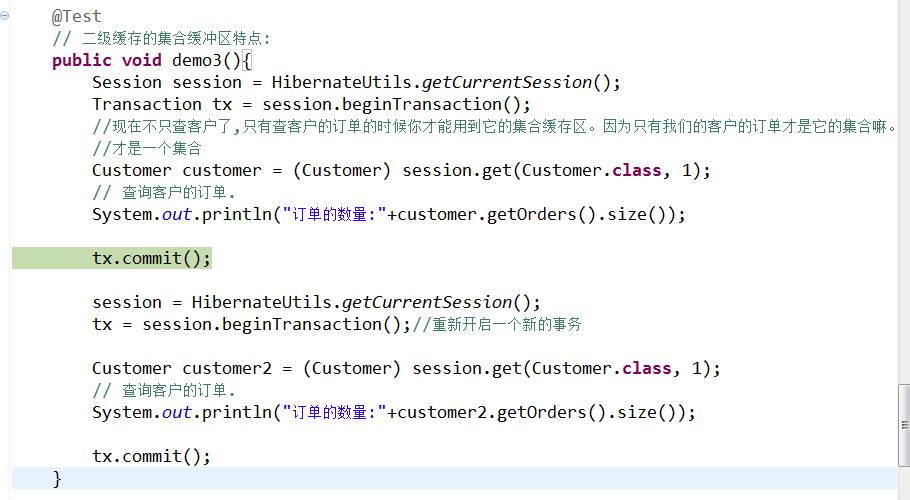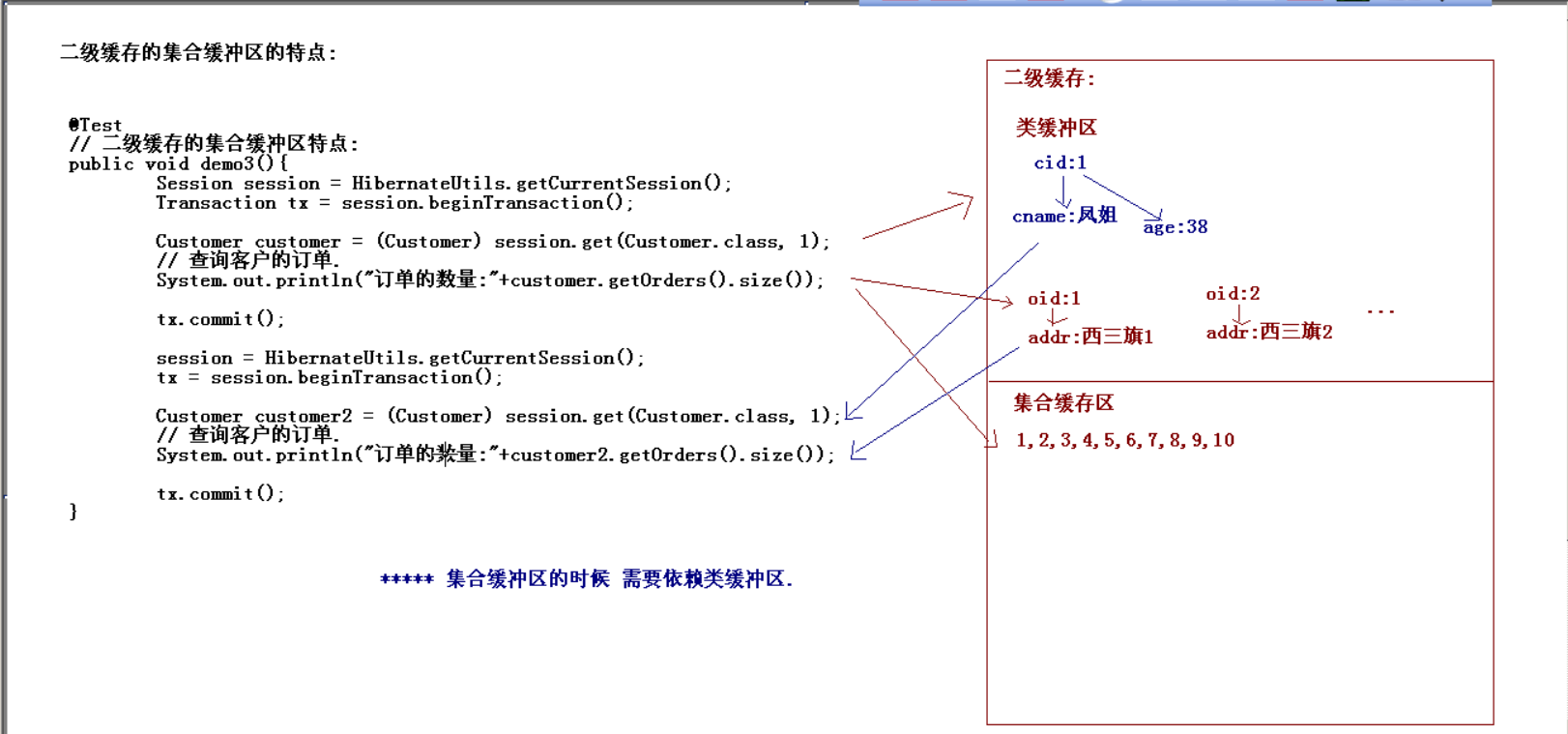
所以说要经常检查hibernate3的核心配置文件hibernate.cfg.xml.

Hibernate:
select
customer0_.cid as cid0_0_,
customer0_.version as version0_0_,
customer0_.cname as cname0_0_,
customer0_.age as age0_0_
from
customer customer0_
where
customer0_.cid=?
Hibernate:
select
orders0_.cno as cno0_1_,
orders0_.oid as oid1_,
orders0_.oid as oid1_0_,
orders0_.addr as addr1_0_,
orders0_.cno as cno1_0_
from
orders orders0_
where
orders0_.cno=?
订单的数量:11


这是咱们的默认情况,fetch="select" lazy="tue"的情况。这种情况发多条SQL语句。所以不是连接查询,而是分步单表查询。
向下执行,查询customer2没有发SQL,因为使用了二级缓存。再向下执行查询customer2的订单也没有发SQL,跟hibernate3核心配置文件hibernate.cfg.xml中的一句话:<collection-cache usage="read-write" collection="cn.itcast.hibernate3.demo1.Customer.orders"/>有关。集合缓冲区 所以在获得客户的订单的数量的时候,就没有再去发送SQL语句了。因为它已经把我们的集合orders也给缓存了。集合缓存区用来缓存对象中的集合。我们现在用的就是对象中的集合,所以它没有发送SQL语句。
现在要证明集合缓存区的数据是依赖于类缓存区的。尝试注释掉<collection-cache usage="read-write" collection="cn.itcast.hibernate3.demo1.Customer.orders"/>这句话。
Hibernate:
select
customer0_.cid as cid0_0_,
customer0_.version as version0_0_,
customer0_.cname as cname0_0_,
customer0_.age as age0_0_
from
customer customer0_
where
customer0_.cid=?
Hibernate:
select
orders0_.cno as cno0_1_,
orders0_.oid as oid1_,
orders0_.oid as oid1_0_,
orders0_.addr as addr1_0_,
orders0_.cno as cno1_0_
from
orders orders0_
where
orders0_.cno=?
订单的数量:11
Hibernate:
select
orders0_.cno as cno0_1_,
orders0_.oid as oid1_,
orders0_.oid as oid1_0_,
orders0_.addr as addr1_0_,
orders0_.cno as cno1_0_
from
orders orders0_
where
orders0_.cno=?
订单的数量:11
取消了集合缓存区的话查询customer2不会发SQL(因为customer2使用了二级缓存)。而查询customer2的订单数量的时候就会发SQL(因为取消了集合缓存区)。如果把查询订单的类缓存区给注释掉的话,把订单的类缓存区 <class-cache usage="read-write" class="cn.itcast.hibernate3.demo1.Order"/>的这句话注释掉的话,而把集合缓存区恢复的话,把<collection-cache usage="read-write" collection="cn.itcast.hibernate3.demo1.Customer.orders"/>这句话取消注释的话,
Hibernate:
select
customer0_.cid as cid0_0_,
customer0_.version as version0_0_,
customer0_.cname as cname0_0_,
customer0_.age as age0_0_
from
customer customer0_
where
customer0_.cid=?
Hibernate:
select
orders0_.cno as cno0_1_,
orders0_.oid as oid1_,
orders0_.oid as oid1_0_,
orders0_.addr as addr1_0_,
orders0_.cno as cno1_0_
from
orders orders0_
where
orders0_.cno=?
订单的数量:11
Hibernate:
select
order0_.oid as oid1_0_,
order0_.addr as addr1_0_,
order0_.cno as cno1_0_
from
orders order0_
where
order0_.oid=?
Hibernate:
select
order0_.oid as oid1_0_,
order0_.addr as addr1_0_,
order0_.cno as cno1_0_
from
orders order0_
where
order0_.oid=?
Hibernate:
select
order0_.oid as oid1_0_,
order0_.addr as addr1_0_,
order0_.cno as cno1_0_
from
orders order0_
where
order0_.oid=?
Hibernate:
select
order0_.oid as oid1_0_,
order0_.addr as addr1_0_,
order0_.cno as cno1_0_
from
orders order0_
where
order0_.oid=?
Hibernate:
select
order0_.oid as oid1_0_,
order0_.addr as addr1_0_,
order0_.cno as cno1_0_
from
orders order0_
where
order0_.oid=?
Hibernate:
select
order0_.oid as oid1_0_,
order0_.addr as addr1_0_,
order0_.cno as cno1_0_
from
orders order0_
where
order0_.oid=?
Hibernate:
select
order0_.oid as oid1_0_,
order0_.addr as addr1_0_,
order0_.cno as cno1_0_
from
orders order0_
where
order0_.oid=?
Hibernate:
select
order0_.oid as oid1_0_,
order0_.addr as addr1_0_,
order0_.cno as cno1_0_
from
orders order0_
where
order0_.oid=?
Hibernate:
select
order0_.oid as oid1_0_,
order0_.addr as addr1_0_,
order0_.cno as cno1_0_
from
orders order0_
where
order0_.oid=?
Hibernate:
select
order0_.oid as oid1_0_,
order0_.addr as addr1_0_,
order0_.cno as cno1_0_
from
orders order0_
where
order0_.oid=?
Hibernate:
select
order0_.oid as oid1_0_,
order0_.addr as addr1_0_,
order0_.cno as cno1_0_
from
orders order0_
where
order0_.oid=?
订单的数量:11
不仅仅发了,而且发了很多条SQL。那样的话有多少个订单就发多少条SQL。这其实跟我们的集合缓存区的结构特性有关。
这是刚才二级缓存的类缓存区的散装数据。

二级缓存区分为类缓存区和集合缓存区等等。集合缓存区里面缓存的都是对象的id,而且它是需要依赖类缓存区的。类缓存区缓存的是对象的散装数据。可以通过cid引用这两个属性的值。就是一查Customer,它就会这样去做了。获得订单是我们的集合缓存区。集合缓存区缓存的都是对象的id。它会把我们所有的订单的id给缓存了。集合缓存的是我们订单的id。集合缓存区的使用需要依赖类缓存区。oid对addr有引用。类缓存区是有这些对象数据的。它就不发sql了,直接从二级缓存区获取了。如果不开放/配置类缓存区,它就会根据对象的id一个个地去检索。

下面是同时开放/配置Order类缓存区和集合缓存区的效果:
Hibernate:
select
customer0_.cid as cid0_0_,
customer0_.version as version0_0_,
customer0_.cname as cname0_0_,
customer0_.age as age0_0_
from
customer customer0_
where
customer0_.cid=?
Hibernate:
select
orders0_.cno as cno0_1_,
orders0_.oid as oid1_,
orders0_.oid as oid1_0_,
orders0_.addr as addr1_0_,
orders0_.cno as cno1_0_
from
orders orders0_
where
orders0_.cno=?
订单的数量:11
订单的数量:11
<?xml version="1.0" encoding="UTF-8"?> <!DOCTYPE hibernate-configuration PUBLIC "-//Hibernate/Hibernate Configuration DTD 3.0//EN" "http://www.hibernate.org/dtd/hibernate-configuration-3.0.dtd"> <hibernate-configuration> <session-factory> <!-- 必须去配置的属性 --> <!-- 配置数据库连接的基本信息: --> <property name="hibernate.connection.driver_class"> com.mysql.jdbc.Driver </property> <property name="hibernate.connection.url"> jdbc:mysql:///hibernate3_day03 </property> <property name="hibernate.connection.username">root</property> <property name="hibernate.connection.password"></property> <!-- Hibernate的方言 --> <!-- 生成底层SQL不同的 --> <property name="hibernate.dialect"> org.hibernate.dialect.MySQLDialect </property> <!-- 可选的属性 --> <!-- 显示SQL --> <property name="hibernate.show_sql">true</property> <!-- 格式化SQL --> <property name="hibernate.format_sql">true</property> <property name="hibernate.connection.autocommit">false</property> <!-- hbm:映射 to DDL: create drop alter --> <property name="hibernate.hbm2ddl.auto">update</property> <!-- 设置事务的隔离级别 --> <property name="hibernate.connection.isolation">4</property> <!-- 设置本地Session --> <property name="hibernate.current_session_context_class">thread</property> <!-- C3P0连接池设定--> <!-- 使用c3po连接池 配置连接池提供的供应商--> <property name="connection.provider_class"> org.hibernate.connection.C3P0ConnectionProvider </property> <!-- Hibernate中开启二级缓存 --> <property name="hibernate.cache.use_second_level_cache">true</property> <!-- 配置二级缓存的提供商 --> <property name="hibernate.cache.provider_class">org.hibernate.cache.EhCacheProvider</property> <!-- 配置查询缓存 --> <property name="hibernate.cache.use_query_cache">true</property> <!--在连接池中可用的数据库连接的最少数目 --> <property name="c3p0.min_size">5</property> <!--在连接池中所有数据库连接的最大数目 --> <property name="c3p0.max_size">20</property> <!--设定数据库连接的过期时间,以秒为单位, 如果连接池中的某个数据库连接处于空闲状态的时间超过了timeout时间,就会从连接池中清除 --> <property name="c3p0.timeout">120</property> <!--每3000秒检查所有连接池中的空闲连接 以秒为单位--> <property name="c3p0.idle_test_period">3000</property> <!-- 通知Hibernate加载那些映射文件 --> <mapping resource="cn/itcast/hibernate3/demo1/Customer.hbm.xml" /> <mapping resource="cn/itcast/hibernate3/demo1/Order.hbm.xml" /> <!-- 配置哪些类使用二级缓存 --> <class-cache usage="read-write" class="cn.itcast.hibernate3.demo1.Customer"/> <!--查询订单的类缓存区--> <class-cache usage="read-write" class="cn.itcast.hibernate3.demo1.Order"/> <!-- 集合缓冲区 所以在获得客户的订单的数量的时候,就没有再去发送SQL语句了。因为它已经把我们的集合orders也给缓存了。集合缓存区用来缓存对象中的集合。 我们现在用的就是对象中的集合,所以它没有发送SQL语句。证明集合缓存区的数据是依赖于类缓存区的。 --> <collection-cache usage="read-write" collection="cn.itcast.hibernate3.demo1.Customer.orders"/> </session-factory> </hibernate-configuration>
@Test // 二级缓存的集合缓冲区特点: public void demo3(){ Session session = HibernateUtils.getCurrentSession(); Transaction tx = session.beginTransaction(); //现在不只查客户了,只有查客户的订单的时候你才能用到它的集合缓存区。因为只有我们的客户的订单才是它的集合嘛。Customer.hbm.xml里面的<set name="orders"> //才是一个集合 Customer customer = (Customer) session.get(Customer.class, 1); // 查询客户的订单. System.out.println("订单的数量:"+customer.getOrders().size()); tx.commit(); session = HibernateUtils.getCurrentSession(); tx = session.beginTransaction();//重新开启一个新的事务 Customer customer2 = (Customer) session.get(Customer.class, 1); // 查询客户的订单. System.out.println("订单的数量:"+customer2.getOrders().size()); tx.commit(); }
